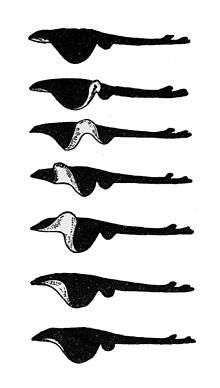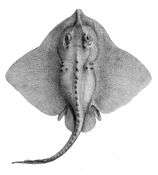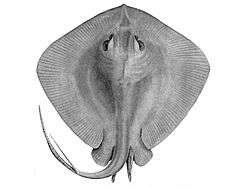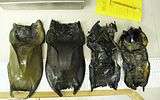Skate (fish)
| Skates Temporal range: Late Cretaceous–Recent | |
|---|---|
 | |
| Arctic skate, Amblyraja hyperborea | |
| Scientific classification | |
| Kingdom: | Animalia |
| Phylum: | Chordata |
| Class: | Chondrichthyes |
| Subclass: | Elasmobranchii |
| Superorder: | Batoidea |
| Order: | Rajiformes Berg, 1940 |
| Family: | Rajidae Bonaparte, 1831 |
Skates are cartilaginous fish belonging to the family Rajidae in the superorder Batoidea of rays. More than 150 species have been described, in 17 genera.[2] Softnose skates and pygmy skates were previously treated as subfamilies of Rajidae (Arhynchobatinae and Gurgesiellinae), but are now considered distinct families.[2] Alternatively, the name "skate" is used to refer to the entire Rajiformes order (families Anacanthobatidae, Arhynchobatidae, Gurgesiellidae and Rajidae).[2]
Members of Rajidae are distinguished by their stiff snout and a rostrum that is not reduced.[3][4]
Genera
There are 17 genera in Rajidae:[2]
- Amblyraja
- Beringraja
- Breviraja
- Dactylobatus
- Dentiraja
- Dipturus
- Hongeo
- Leucoraja
- Malacoraja
- Neoraja
- Okamejei
- Orbiraja
- Raja
- Rajella
- Rostroraja
- Spiniraja
- Zearaja
Skates versus rays


| Comparison of skates and stingrays | |||
|---|---|---|---|
| Superficially, skates and stingrays appear somewhat similar.
 Skate  Stingray However, there are fundamental differences. | |||
| Characteristic | Skates | Rays | Sources |
| Reproduction | Skates are oviparous, that is they lay eggs. Their fertilized eggs are laid in a protective hard case called a mermaid's purse. | Rays are viviparous, that is, they bear their young inside their bodies and give birth to them alive. | [5] |
| Dorsal fin | Distinct | Missing or vestigial | [5] |
| Pelvic fins | Fins are divided into two lobes | Fins have one lobe | [6] |
| Tail | Fleshy tails which lack spines | Whip-like with one or two stinging spines | [5][6] |
| Protection | Rely on "thorny projections on their backs and tails for protection from predators" | Rely on their stinging spines or barbs for protection | [5] |
| Teeth | Small | "Plate-like teeth adapted for crushing prey" | [5] |
| Size | Usually smaller than rays | Usually larger than skates | [5] |
| Colour | Often drab, brown or gray (but not always) | Often boldly patterned (but not always) | [6] |
| Habitat | Often deep water (but not always) | Often shallow water (but not always) | [6] |
Conservation
Skates have slow growth rates and, since they mature late, low reproductive rates. As a result, skates are vulnerable to overfishing and appear to have been overfished and are suffering reduced population levels in many parts of the world. The barndoor skate, Dipturus laevis, is currently listed with the IUCN as vulnerable due to being severely overfished.[7]
In 2010, Greenpeace International added the barndoor skate, bottlenose skate, and maltese skate to its seafood red list. "The Greenpeace International seafood red list is a list of fish that are commonly sold in supermarkets around the world, and which have a very high risk of being sourced from unsustainable fisheries."[8]
Gallery
.gif)
 Big skate egg cases; egg case on the left is fresh and older ones are to the right
Big skate egg cases; egg case on the left is fresh and older ones are to the right
See also
- Jenny Haniver, a fake sea monster created from a skate corpse.
- Hongeohoe, a Korean dish made from fermented skate.
- Mokpo, a South Korean city famous for its skate cuisine.
References
- ↑ Froese, Rainer, and Daniel Pauly, eds. (2009). "Rajidae" in FishBase. January 2009 version.
- 1 2 3 4 LAST, P.R. & SÉRET, B. & STEHMANN, M.F.W. & WEIGMANN, S. (2016) Skates, Family Rajidae. In: Last, P.R., White, W.T., Carvalho, M.R. de, Séret, B., Stehmann, M.F.W & Naylor, G.J.P (Eds.) Rays of the World. CSIRO Publishing, Melbourne: 204–363
- ↑ EBERT, D.A. (2003) The Sharks, Rays and Chimaeras of California. University California Press, Berkeley, CA. 284 pp.
- ↑ COMPAGNO, L.J.V. (1999) Chapter 1. Systematics and body form. pp. 1–42. In: W.C. Hamlett, ed. Sharks, skates and rays. The biology of elasmobranch fishes. Johns Hopkins Press, Maryland.
- 1 2 3 4 5 6 Ichthyology: Ray and Skate Basics Florida Museum of Natural History. Retrieved 21 March 2013.
- 1 2 3 4 Skate or Ray? ReefQuest Centre for Shark Research. Retrieved 212 March 2013.
- ↑ Florida Museum of Natural History
- ↑ Greenpeace International Seafood Red list
External links
| Wikispecies has information related to: Rajidae |
| Look up skate in Wiktionary, the free dictionary. |
| Wikibooks Cookbook has a recipe/module on |
- ARKive - images and movies of the common skate (Dipturus batis)
- Kliman, Todd. "Skate Goes From Trash Fish to Treasure", Washingtonian, May 1, 2006.
| Wikimedia Commons has media related to Rajidae. |